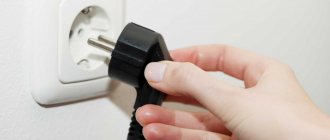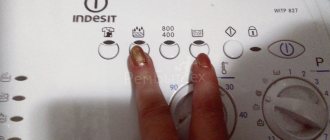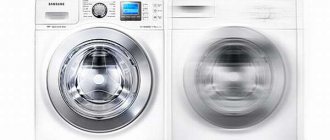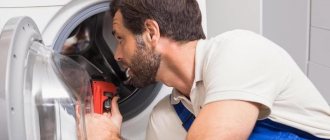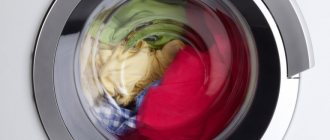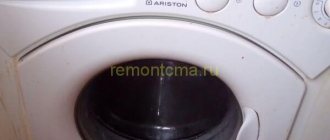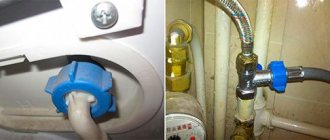Is your washing machine shaking and humming like a rocket about to take off? In this article we will talk about the main causes of noise and vibration during spinning. Let's look at how you can fix problems yourself and when you should still contact a specialist.
The connection manual is universal, suitable for all models with vertical and horizontal loading of the brands Ariston, Bosch, Candy, Gorenje, Indesit, Samsung, Siemens, Zanussi, Ariston, Bosch, Aeg, Beko, Electrolux, Haier and others.
Go!
Failure to comply with operating rules
The most common reason. The round shape of the drum helps to mix wet laundry into one pile. Manufacturers write in all instructions about the need to put small and medium-sized items into the machine along with large and bulky items to create balance. But it’s enough to leave one duvet cover unfastened for them all to become one big heap, which is difficult to turn around. To prevent such situations, you need to put the laundry folded for washing, making sure to fasten all the zippers and buttons.
Overload can also cause the washer to bounce and jump. In this case, stop the machine, drain the water and separate the laundry into parts. Always load laundry evenly, since the service life of the equipment depends on proper use.
Which models vibrate most often?
Despite new developments in the design of automatic machines, manufacturers are unable to achieve complete noise reduction. Rapid rotation of the drum, natural vibration is most pronounced in:
- built-in narrow models of the brands LG, Indesit. The narrow body and reduced support lead to movements due to poor fastening or improper installation;
- cars with metal tanks. The noise is due to poor sound insulation;
- small-sized equipment.
Compared to full-size models, manufacturers use fewer engine-silencing devices. Narrow built-in model Metal tank Difference between standard and small model
Important! The optimal noise level during washing is 50 dB, during spinning - 70 dB. The indicator is written in the device passport.
Rules for loading laundry
To prevent noise and jumping of the washing machine, you need to put the optimal number of things in the drum. The capacity of the model, for example, 6 kg, indicates that you can load up to 6 kg. Before the program starts, the laundry is straightened and evenly laid out on the drum.
Be sure to pay attention to the maximum load
If there is a lack of weight, the automatic machine spins without being weighed down. Free movement of the drum leads to loosening. If you regularly wash one item, the device may break.
Technical reasons
In addition to operational reasons, there are many other reasons why a machine knocks and moves (“dances”). Incorrect installation of equipment, failure of important parts and components. It can be difficult to fix such problems on your own. However, if they are diagnosed correctly, it is quite possible.
The floor is uneven or slippery
Uneven position of the legs is one of the common reasons that the machine rattles and bounces. To verify this, simply shake the machine. If it wobbles, determine which direction is more. And on this side, twist the leg, lifting it higher. This problem is common in homes with wood floors. Here you need to spend a lot of time to bring the machine into a perfectly level position.
Slippery floors are another possible cause. The washing machine simply rides on its rubberized legs on wet marble or tiles. Sometimes this happens on laminate flooring too. The solution may be to purchase special pads that will hold firmly even on the most slippery surfaces. Other options: an anti-slip silicone mat or moving it to another location.
Installation not level
If the machine is tilted to one side, the counterweight located inside the body, which holds it during operation, will be directed in that direction. This problem can be identified visually by examining the machine from a distance. If there is a building level, it will show exactly where the machine is tilted. To correct the situation, it is enough to place the equipment correctly.
Shipping bolts not removed
If the new machine hums, trembles and “walks”, the transport bolts may not have been removed. They are located on the back wall and are installed so that the drum remains in place during transportation. As a rule, there are four bolts. Unscrew with a regular screwdriver.
Don't throw them away: when moving, shipping bolts will help keep the mechanical insides of the machine intact.
Shock absorbers and dampers
Shock absorbers are cylinder-like parts with a rod, a piston and a “return” spring. Designed to dampen vibrations that appear at high speeds. Improved shock absorbers with an entire spring system are called “dampers”. Some modern car brands are equipped with them.
The service life of both is quite limited. They can fail if overloaded frequently. You can check the serviceability of the shock absorbers by removing the rear or front part of the car.
To begin with, try simply pressing on the tank. If it immediately snaps into place, then everything is fine with them. Otherwise, the tank will return with a slight delay.
All specified parts are paired. Therefore, if one shock absorber fails, both need to be replaced. Their cost is low, much cheaper than an additional call to a specialist. The same applies to dampers.
It's also worth checking the springs that support the tank. They are located on both sides and can stretch from prolonged use. They can also be replaced in pairs.
The engine runs rough
In addition to the stable and even noise of vibration or knocking, a completely different, sharp sound may occur, usually accompanied by a burning smell. This is a sign of engine failure. This happens due to its long service life, voltage surge or burnout of the armature winding.
If such sounds are produced by a recently purchased car, we are talking about a defective manufacturer. In this case, it is better to contact the service center while the warranty is valid (for washing machines, as a rule, for at least a year).
Objects stuck between drum and tank
Sometimes locks, brooches and other decorations fall out during washing. They fall into the holes of the drum and, periodically catching on it, make creaking sounds. To detect foreign objects, just look under the hatch cuff. If the object fell further, you will have to unscrew the heating element and other elements.
Bearings are worn out
The washing machine makes a characteristic noise and rumbles: the bearings may have failed. Rotate the drum by hand. Inhomogeneous rotation, sometimes quite difficult, indicates that it is time to replace this consumable.
If this is not done in a timely manner, excessive load will appear on the shaft and drum, which will lead to more expensive repairs in the future. Bearings are considered consumable items, requiring replacement every 3-5 years. Fortunately they are inexpensive. If you wish, you can replace them yourself.
The belt has dried out
If the drum spins too easily and produces an unpleasant scraping sound, there may be a problem with the direct drive. The drive belt serves to connect the drum and the engine. Infrequent use of the washing machine or prolonged work on worn out bearings leads to weakening of the tension. How to accurately determine that the problem is in the belt and what to do about it can be read here.
Damaged shaft
In addition to strong vibration and “jumping,” damage to the shaft may be indicated by rusty stains at the bottom of the washing machine. This is a serious breakdown. You won’t be able to fix it yourself without the proper experience.
Fastenings of internal elements are loose
Another reason why the washing machine “walks” and even “dances” on the surface may be insufficient fastening of the internal elements. If this is not corrected in a timely manner, several main components will fail at once. Therefore, you should check how well the crosspiece, counterweight and fasteners supporting the tank are tightened. If necessary, secure more firmly.
What do experts advise when your washing machine jumps?
- Use the included noise-insulating rubber or silicone pads for the legs;
- When installing, lay an additional soundproofing layer behind the wall of the machine;
- Built-in models require additional space to prevent the headset from loosening;
- Load the equipment so that it is 1/3 free;
- Remove shipping bolts before installation and connection;
- Use a magnet or vacuum cleaner to remove small objects;
- Sort items by size and fabric type before storing;
- It is better to entrust the replacement of the engine, bearings, and springs to a specialist.
Watch a video about what to do if the washing machine jumps during the spin cycle
Tips and tricks
In most cases, you can remove the vibration of the washing machine during the spin cycle yourself. To do this, it is enough to evaluate how level it is using a level. If you don’t have one, use a bottle half filled with water, on which draw a straight vertical line in the center. After this, place the container on the washer and see how much the water level deviates from the horizon.
To prevent the washing machine from jumping and humming here and now, you can use the following items:
- Place cardboard and thick paper under the legs on the swinging side.
- If the floor is too slippery, use a cotton rag - it will increase resistance and allow you to complete the wash cycle.
- In the future, it is better to buy an anti-vibration and anti-slip mat.
Nuances of troubleshooting
If the washing machine often jumps during a quick spin cycle, then experts will tell you what to do with it. Independently allowed:
- Remove transportation fasteners based on the manufacturer's instructions;
- Adjust the legs in height and install equipment according to the level;
- Install anti-vibration devices - mats and stands;
- Determine bearing failures by turning or rocking the drum;
- Repair the upper, front or rear counterweight by removing the upper housing;
- Tighten the fastenings of parts if they become loose.
Important! If you are not confident in your abilities and knowledge, entrust the repair to specialists.
Identifying the problem
To determine why the washer jumps during the spin cycle, you must first listen to the sounds it makes:
- if the problem lies in the bearings, then a characteristic grinding noise is heard during movement;
- in the event of a breakdown of the shock absorbers, springs or counterweight, a knock is heard, indicating that the drum is hitting the body;
- when the equipment is not positioned correctly, the laundry is unevenly distributed, or the transport bolts are not removed, the washing machine makes a rumble, but there is no knocking or grinding.
You can try shaking the washing machine. When installed correctly, it should not slide or wobble. You can detect fallen fragments by shining a flashlight through the drum grille. The transport bolts are also easy to find: they are located on the rear wall of the machine.
To determine problems with shock absorbers, you need to put the car on its side and look at it from below. Finding difficulties with counterweights, springs and their fastening requires removing the top and front panels of the device.
Unbalanced laundry in the drum
Another common occurrence is when small items, during the washing and spinning process, form a lump inside a larger item, for example, in a pillowcase or duvet cover. As a result, a heavy lump is formed, the mass shifts during movement - during spinning, the machine jumps in the direction of displacement and rotation of the drum. In this case, an error may be projected on the display in the form of the letter values UE or UB. This is a direct sign that the drum is spinning with interference.
The solution is simple: emergency drainage, redistribution of things inside the machine after unlocking the door. Then just start the spin cycle.
Advice! Wash small items and underwear in special bags. This will prevent imbalance and preserve delicate fabrics.
Uneven floor
If all the parts are connected correctly, but the machine still jumps, the cause may be a crooked floor. To check this guess, you should shake the product slightly: on an uneven surface it will “limp”.
To regulate the machine, its manufacturers have provided special legs that need to be gradually screwed in and out to level the device. The process will go faster if you use a building level.
Bearing
Why does the washing machine vibrate? This may happen due to faulty bearings. When water gets on it, it is destroyed. At the beginning, an iron grinding sound appears, later the drum begins to move from side to side, and the machine itself jumps.
The problem can be solved by replacing the bearing. This needs to be done as soon as possible. Ignoring the problem will only lead to the failure of the entire system.
It's better to call a machine repairman. Replacing a bearing yourself is very difficult.

